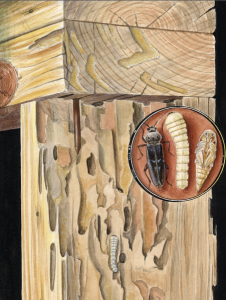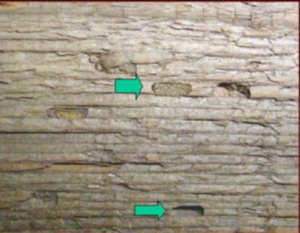What would you think of me if I told you I didn’t know every single wood infesting bug that is out there or that may be in your home? Would you think of me as unqualified to service your home or inspect for termites? I’m sure (well I hope anyway) you’d say “oh no one knows it all and there are way too many bugs for that.” In reality people expect termite inspectors to know the bugs that could eat their investment and rightfully so. I feel confident in saying that most inspectors can and do identify what is considered a wdo (wood destroying organism) however, termite inspectors are not mandated to know every insect or circumstance in which a non wdo is found in the wood of your structure and that is where customers can become disillusioned with their inspection results.
Like so many other termite companies across America I get calls for termite inspections almost every single day for the purpose of the sale or refinancing of a home. To be more accurate the report includes other, ‘re-infesting, wood destroying insects and organisms‘ as well as termites and should I find anything that fits the definition it is my job to report this on the appropriate form to the person who requested the work. In the end I’ve done my job and any action needed on the basis of my report can be taken at that time. Where the problem comes in is when I find non ‘re-infesting, wood dwelling insects or organisms.’ Am I responsible to put these findings on the report? Am I obligated to know exactly what that something is? Now just what is a termite inspectors responsibility then?
Boy I’ve got a lot of questions here and in reality I’m only using them to illustrate a point. No one would argue that if I found fleas or
roaches that this wouldn’t go on the report because they do not damage the wood. There are however a number of bugs or organisms you can find on or in a stud, floor joist or wood siding that also have no effect and cause no reoccurring damage but still the customer almost always demands that you explain what it is and where it came from. The scope of the inspection however only includes certain insects or organisms and state agencies mandate that an inspector have adequate knowledge of those pests on the list and not every other possible bug it could be. As I stated in the beginning, no one knows every bug, organism or possible cause of damaged wood and at times all the inspector can do is tell you what it is not and this should suffice but it rarely does.Over the years I have been called out to explain some really strange things, some I’ve figured out and others were left unanswered. One man threatened to sue me for damaged wood on a truss in the attic and it turned out to be chain marks from when the trusses were fastened to the delivery truck that brought them in. On the other end of that spectrum I’ve also been called an s.o.b. for reporting subterranean termite tunneling and damage to a roof truss high in the attic that obviously occurred while the truss was laying on the ground too long waiting for the men to install it and the termites took advantage. In both cases the circumstances made no sense but the report is a simple yes or no question yet the poor bug man is left to not only know what caused the problem but just how it came about.
Then there are the many insects that burrow or live in the wood but are not considered wood destroying and while they technically cause damage, they are not on the list of wood destroying insects so they are not to be noted. They may make holes in the wood, or travel up and down making squiggly little hewed out trails but still are no threat because once they exit they do not return. Examples of these might be one of the many bark borers whose evidence wasn’t quite cut out of the wood at the mill. Wood wasps that will drill into a timber to lay an egg leaving a 1/4 inch hole. Even the flat head borer that can live in wood for two years is considered non re-infesting so there’s no place for him in the wdo inspection.
In the medical field Doctors narrow down what ails you by finding out what isn’t the problem. They call this process “ruling out.” Basically they look at signs or symptoms and if what they’re looking at doesn’t fit in the parameters of what they’re looking for they rule that problem out and move on to the next possibility. In termite inspections we also rule things out. For example, we may have a exit hole in the wood packed with dull looking frass but with the absence of mud we rule out subterranean termites. The hole is larger than a BB so we cross off powder post beetles and move on ruling out carpenter bees drywood termites etc. We also know that the wood is a hard wood so we can cross out old house borers and we run through the evidence until we’ve either concluded what the bug is or more importantly, what it isn’t. In this example the offending bug would be the flathead borer and is not on our wood destroying insect list so we simply do not put it on the report. Now if we didn’t know about the flathead borer biology or some other strange thing we’re examining but we were still able to rule out wdo’s then our task would still be complete. (this principle is especially useful for wood decaying fungus)
Of course it pays to know all the insects and their signs we can but it really is more important to understand completely the insects that we are charged with finding. I take every opportunity to learn all I can when I get stumped but I don’t lose any sleep on the accuracy of my report because while I may not know what a particular insect is, I do know what it isn’t.






